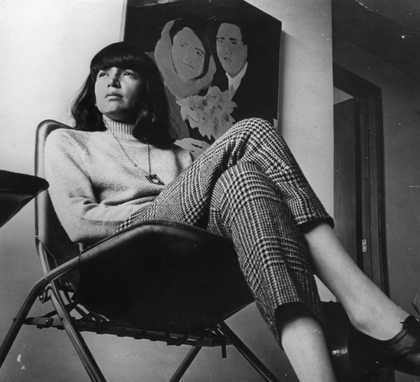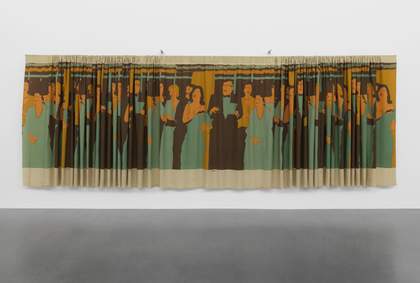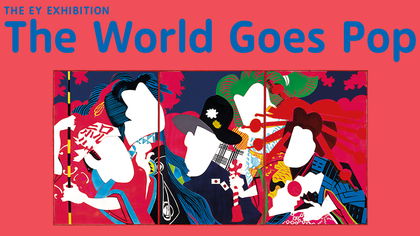
Beatriz González with The Suicide of the Sisga in c.1965
Photo: Alfonso Ángel
Who is she?
Beatriz González is a Colombian painter, associated with the Pop Art movement. She grew up in Colombia in the 40s and 50s, during an era of political unrest known as La Violencia (The Violence).
Initially González was a traditional painter, inspired by Vermeer and Velazquez, but later began to refer to the mass media as a source of inspiration instead. She used bold colours and flat figures to represent images taken from magazines and newspapers as a means of documenting the political and social climate of her homeland. With characteristic tongue-in-cheek humour, González calls these her ”underdeveloped painting[s] for underdeveloped countries.”
I painted the joy of the underdeveloped… Mine was a provincial type of art without horizons, confronting the everyday.
Interview with Tate, 2015
Does she consider herself a pop artist?
Not really. In her interview with Tate, González explains why the term Pop was not relevant to her until perhaps later on in her career:
In the early 1960s pop was an unknown term… Pop was part of a discourse happening abroad. Really pop art was absent from the medium in which I specialised: painting. Pop could be fashionable, a classification or an exercise, but it wasn’t the appropriate label for the work I was doing, or a vision informing my way of painting…
Interview with Tate, 2015

Beatriz González
Interior Decoration 1981
© Beatriz Gonzalez
View the main page for this artwork
What are her key works?
The most well known of González’s works are The Sisga Suicides I, II and III, 1965. This was the piece which marked her transition from traditional painting to what we known call ‘Pop Art’:
The Suicides of the Sisga was inspired by a story that appeared in the press about a [young] couple: the man, guided by mystical insanity, convinced his girlfriend to commit suicide in order to preserve the purity of their love. Before jumping from the dam of the Sisga on the outskirts of Bogotá, the couple commissioned a professional photographer to take their portrait. The picture was then sent on to their families and when the news broke it was widely reprinted in black and white in local newspapers… The quality, or ‘the bad quality’ of the image, awoke my interest in this. I was attracted by… the simplification of the facial features, almost deformed by the discrepancy.
Interview with Tate, 2015
Mr. President, What an Honor to be With You at This Historic Moment I and II were created in response to a mass killing in 1985. Armed guerrillas took many magistrates hostage in the Palace of Justice in Bogota. The military responded by bombing the building; killing both guerillas, magistrates and civilians alike.
The first of González’s paintings shows an happy President and his cabinet, sitting at a table with a bright red bouquet of flowers in the centre of the table, and uniformed soldiers at their side. In the second painting, which lacks the bright colours of the first, the flowers are replaced by a burnt human torso.
González also became well known for her furniture pieces, which combined her paintings with found and adapted household items. Here she describes her first work of this series The Last Supper:
I found a metal bed, imitating wood. This piece of furniture was called ‘radio bed’, because embedded in its structure was a dedicated space for a radio… At home, I was completing a painting on a metal sheet, the Señor de Monserrate, to be hung on a wall. When I began to ask myself ‘what should we do with the bed?’, it dawned on me that I should lie the painting on its back and fit it in the bed structure, and destiny made it fit precisely… This moment still seems magical to me…
Interview with Tate, 2015
What do the critics say?
Its determinedly rough, anti-academic painting style – awkward forms, workaday surfaces – will not be to all tastes. And its culturally grounded references can make its play of humor, despair and affection hard to interpret. Yet her work is dynamic enough to suggest many things…
Holland Cotter, Art Review
Her art] allows us to reflect on our ethical stance towards the country and the political situation in which we live.
Julian Posada, Curator
The only one who has been able to paint the Colombians.
Luis Caballero, Artist
A tireless investigator of kitsch.
Marta Traba
González in quotes…
Sometimes I see myself like a transgressor that didn’t fit in her time.
Interview with Tate, 2015
I half close my eyes and I can see the colours of Bucaramanga, that I saw in my childhood. The colours of my paintings are those of the sunsets I would watch with my father.
Cromos Revista, 2011
The colour palette and the theme of the paintings… were shocking and out of tune. I deliberately wanted them to be out of tune – these were the colours that I saw in shop windows, in re-interpretations of universal images that were made in the Third World.
Interview with Tate, 2015

